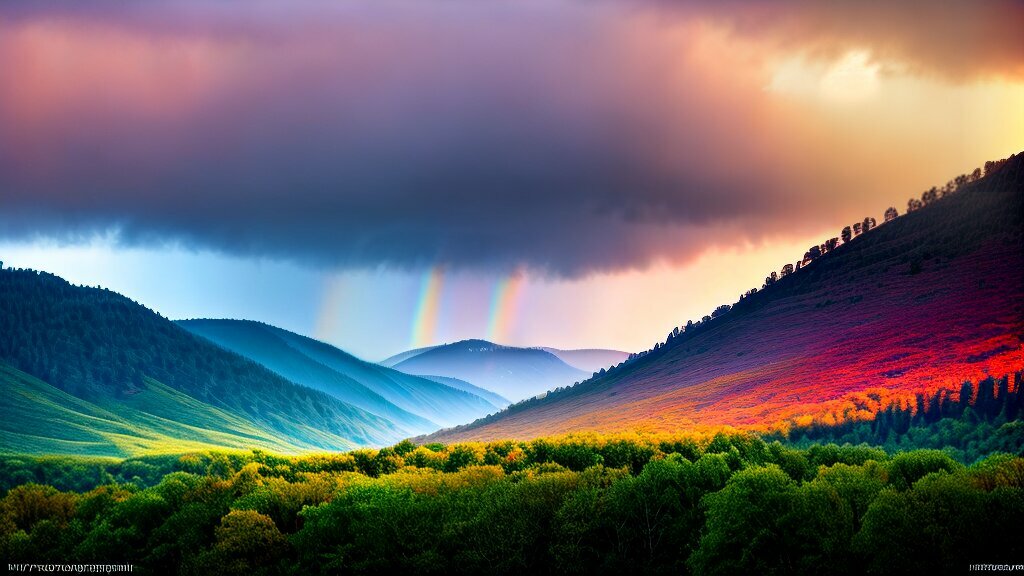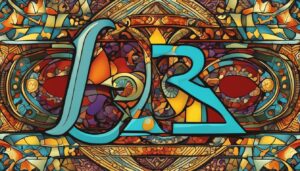Welcome, dear readers, to a fascinating exploration of the symbolism of rainbows in the Bible. We invite you to join us on a journey of discovery, as we uncover the deeper meaning behind this beautiful natural phenomenon that has captivated mankind since the beginning of time.
Have you ever wondered what a rainbow symbolizes in the Bible? Is it a mere coincidence or a divine sign? As we explore relevant biblical verses and their explanations, we will gain a deeper understanding of the spiritual significance of rainbows in a religious context.
Let us begin our quest for wisdom and enlightenment, guided by the wisdom of the scriptures and the illumination of divine revelation.
Key Takeaways:
- The symbolism of rainbows in the Bible has a deep spiritual meaning.
- Relevant biblical verses provide insight into the significance of rainbows as a symbol of hope and divine promises.
The Biblical Significance of the Rainbow
Have you ever wondered about the significance of rainbows in a religious context?
In the Bible, rainbows are more than just a beautiful natural phenomenon. They serve as powerful symbols of hope, promise, and God’s presence among us. From the story of Noah and the flood to the visions of the prophet Ezekiel, rainbows appear as divine messages and reminders of God’s love and faithfulness.
“I have set my rainbow in the clouds, and it will be the sign of the covenant between me and the earth.” – Genesis 9:13 (NIV)
The rainbow first appears in the book of Genesis, after the great flood that purified the world of wickedness and sin. God promises to never again destroy the earth with a flood and sets a rainbow as a sign of his covenant with humanity. The rainbow represents God’s grace and mercy, reminding us of his unwavering love and forgiveness.
The Biblical Significance of the Rainbow as a Symbol of God’s Promises and Covenants
Throughout the Bible, rainbows are repeatedly associated with divine promises and covenants. They serve as visual reminders of God’s faithfulness and commitment to his people.
“When I bring clouds over the earth and the bow is seen in the clouds, I will remember my covenant that is between me and you and every living creature of all flesh.” – Genesis 9:14-15 (ESV)
Rainbows are also tied to specific biblical stories and events, such as the parting of the Red Sea and the visions of the prophet Ezekiel. In each case, rainbows are seen as a symbol of God’s presence and protection, as well as a sign of hope for the future.
The Biblical Significance of the Rainbow as a Symbol of Hope and Renewal
In addition to representing promises and covenants, rainbows are also associated with the concepts of hope and renewal in biblical stories.
“Arise, shine, for your light has come, and the glory of the Lord rises upon you. See, darkness covers the earth and thick darkness is over the peoples, but the Lord rises upon you and his glory appears over you.” – Isaiah 60:1-2 (NIV)
The rainbow’s appearance after a storm serves as a reminder that, even in the darkest times, there is always hope for a brighter future. It symbolizes the renewal and restoration of creation, and the promise of a better tomorrow.
Understanding the biblical significance of rainbows allows us to appreciate these natural wonders on a deeper level. They are more than just breathtaking displays of color – they are reminders of God’s love, grace, and faithfulness. Let us rejoice in the beauty and meaning of rainbows, and let them inspire us to live with hope and purpose.
The Biblical Significance of the Rainbow
As we discussed earlier, rainbows in the Bible are often associated with divine promises and covenants. In fact, one of the most well-known stories that features the rainbow is that of Noah and the flood.
“And God said, ‘This is the sign of the covenant I am making between me and you and every living creature with you, a covenant for all generations to come: I have set my rainbow in the clouds, and it will be the sign of the covenant between me and the earth.’” – Genesis 9:12-13
In this verse, God is making a covenant with Noah and all living creatures on earth, promising to never again destroy the world with a flood. The rainbow is set as a sign of this covenant, a symbol of God’s grace and mercy.
As believers, we can look at the rainbow as a reminder of God’s faithfulness and the promises He has made to us. Just as God kept His promise to Noah, He will also keep His promises to us, no matter what challenges we face in life.
The rainbow is also a symbol of hope and new beginnings. In the story of Noah and the flood, the rainbow appears after the storm has passed, signaling the end of destruction and the beginning of a new era. This can serve as a reminder to us that even in our darkest moments, there is always the promise of a new day and the hope of a brighter future.
Overall, the rainbow serves as a powerful symbol in the Bible, representing God’s presence, promises, and grace. Let us hold onto these messages and find inspiration in the beauty of this breathtaking natural wonder.
God’s Covenant with Noah and the Rainbow
Throughout the Bible, rainbows are often used as a symbol of divine promises and covenants. One of the most notable references to the rainbow can be found in the story of Noah and the flood.
After the great flood, God made a covenant with Noah and his family, promising that he would never again destroy all life on earth with a flood. In Genesis 9:13-16, God says, “I have set my rainbow in the clouds, and it will be the sign of the covenant between me and the earth. Whenever I bring clouds over the earth and the rainbow appears in the clouds, I will remember my covenant between me and you and all living creatures of every kind. Never again will the waters become a flood to destroy all life.”
God’s promise to never again destroy the earth with a flood is symbolized by the rainbow, a beautiful reminder of his grace and mercy.
This covenant with Noah and the rainbow serves as a powerful reminder of God’s faithfulness and love for humanity. The rainbow is a symbol of hope and a promise of new beginnings, reminding us that even in the darkest of times, God is with us.
In Christianity, the rainbow is also associated with God’s grace. As the colors of the rainbow blend together seamlessly, each representing a different aspect of God’s character, we are reminded that God’s grace covers all of our sins and imperfections.
The rainbow is a symbol of God’s everlasting love and faithfulness, reminding us that even in the midst of life’s greatest storms, God is with us, always keeping his promises and guiding us to a brighter future.
The Rainbow as a Symbol of Hope and New Beginnings
When we see a rainbow in the sky, we are reminded of the beauty and wonder of God’s creation. But beyond its breathtaking appearance, the rainbow has deep spiritual significance in the Bible. In fact, it is often used as a symbol of hope and new beginnings.
The story of Noah and the flood is one of the most well-known instances of the rainbow’s symbolism in the Bible. According to Genesis 9:13-16: “I have set my rainbow in the clouds, and it will be the sign of the covenant between me and the earth. Whenever I bring clouds over the earth and the rainbow appears in the clouds, I will remember my covenant between me and you and all living creatures of every kind. Never again will the waters become a flood to destroy all life.”
Here, the rainbow is a symbol of God’s promise to never again bring destruction upon the earth. It represents the hope of a new beginning and a fresh start for humanity. This promise of renewal and restoration is a recurring theme throughout the Bible, and the rainbow serves as a powerful reminder of that promise.
Additionally, the rainbow symbolizes the promise of eternal life and salvation. Revelation 4:3 describes the throne of God as being surrounded by a rainbow, emphasizing the divine nature of this symbol. This image reminds us that God’s promises are not just temporary, but rather, they are eternal and everlasting.
Furthermore, the rainbow represents the ultimate hope of a better world. In Isaiah 11:6-9, the prophet describes a future where predators will peacefully coexist with their prey, and the earth will be filled with the knowledge of the Lord. This vision of a perfect world is symbolized by the rainbow, with its vibrant colors and beauty.
“The rainbow is a reminder that God’s promises are true and that we can trust in his faithfulness.”
Ultimately, the rainbow is a powerful symbol of hope, new beginnings, and the promise of God’s eternal love. It reminds us that even in our darkest moments, there is always light and hope on the horizon. The rainbow is a reminder that God’s promises are true and that we can trust in his faithfulness.
The Rainbow as a Reminder of God’s Presence
When we see a rainbow, we are reminded of the power and glory of God. The colors and beauty of this natural wonder reflect God’s creativity and majesty. In the Bible, rainbows are often associated with God’s presence and sovereignty.
“Whenever the rainbow appears in the clouds, I will see it and remember the everlasting covenant between God and all living creatures of every kind on the earth.” – Genesis 9:16
According to this verse, the rainbow serves as a reminder of God’s covenant with humanity – a promise of protection and provision. When we see a rainbow, we can take comfort in the knowledge that God is with us and will never leave us.
The rainbow also symbolizes God’s faithfulness and love. Just as the rainbow appears after a storm, God’s love and mercy are always present, even in the midst of life’s trials and challenges.
Therefore, whenever we see a rainbow, let us be reminded of God’s presence in our lives. Let us give thanks for God’s everlasting love and faithfulness, and trust in his promises.
The Rainbow as a Symbol of Hope and New Beginnings
As we have already seen, rainbows are often seen as a symbol of divine promises and covenants. But their significance goes beyond that. In the Bible, we also find rainbows associated with hope and new beginnings.
One of the most famous stories in which a rainbow appears is the account of Noah and the flood. After wiping out the wickedness of the world with the deluge, God promises to never again destroy the earth by flood and sets the rainbow as a token of this covenant (Genesis 9:12-13). For Noah and his family, the sight of the rainbow was a sign of hope and a new beginning, a promise of God’s mercy and grace.
“I establish my covenant with you, that never again shall all flesh be cut off by the waters of the flood, and never again shall there be a flood to destroy the earth.” And God said, “This is the sign of the covenant that I make between me and you and every living creature that is with you, for all future generations: I have set my bow in the cloud, and it shall be a sign of the covenant between me and the earth.” (Genesis 9:11-13)
The rainbow, then, reminds us that God is a God of second chances, that no matter how dire our situation may seem, there is always hope for a new beginning. As we look at the colors of the rainbow, we can see a progression from darkness to light, from the storm to calm. The rainbow is a reminder that even in the darkest of times, there is a glimmer of light that can guide us forward and give us hope for a better tomorrow.
Moreover, the rainbow is a symbol of renewal and restoration. In the book of Revelation, we see a vision of a throne surrounded by a rainbow, symbolizing the promise of a new heaven and a new earth (Revelation 4:3). The rainbow reminds us that no matter what our present circumstances may be, there is a future where all things will be made new.
“And he who was seated was like jasper and carnelian in appearance, and around the throne was a rainbow that looked like an emerald.” (Revelation 4:3)
In conclusion, rainbows are a powerful symbol of hope and new beginnings in the Bible. From the story of Noah and the flood to the vision of a new heaven and a new earth in Revelation, the rainbow reminds us of God’s mercy, grace, and promise of renewal. Let us look to the colors of the rainbow and be inspired to hope for a better future, knowing that our God is a God of second chances and new beginnings.
The Rainbow as a Reminder of God’s Presence
As we’ve explored throughout this article, rainbows in the Bible are powerful symbols of divine promises, covenants, hope, and renewal. But rainbows also serve as a reminder of God’s presence in our lives.
In the book of Ezekiel, we read, “Like the appearance of a rainbow in a cloud on a rainy day, so was the appearance of the brightness all around it. This was the appearance of the likeness of the glory of the Lord” (Ezekiel 1:28). This verse emphasizes the connection between rainbows and the glory of God, reminding us of the majesty and power of our Creator.
Furthermore, the book of Revelation describes a vision of a throne in heaven, encircled by a rainbow with “the appearance of an emerald” (Revelation 4:3). This depiction highlights the eternal presence of God and the magnificence of His divine throne.
As we gaze upon a rainbow, we can be reminded of God’s ever-present love, compassion, and grace in our lives. Just as the colors of the rainbow span across the sky, so too does God’s presence extend throughout all of creation.
“The Lord is my rock and my fortress and my deliverer, my God, my rock, in whom I take refuge, my shield, and the horn of my salvation, my stronghold.” (Psalm 18:2)
The Significance of Rainbows in the Bible: A Deeper Understanding
Throughout the Bible, rainbows are used as powerful symbols of God’s promises, covenants, and faithfulness. As we explore the deeper meaning behind the biblical symbolism of rainbows, we gain a greater appreciation for the beauty and majesty of this natural wonder. Let us review the key messages and inspiration behind this breathtaking phenomenon.
The Rainbow as a Symbol of Divine Promises and Covenants
The story of Noah and the flood is one of the most famous examples of the biblical symbolism of rainbows. In Genesis 9:13-16, God tells Noah, “I have set my rainbow in the clouds, and it will be the sign of the covenant between me and the earth.” This passage emphasizes the significance of the rainbow as a symbol of God’s promises and covenants. It serves as a reminder that God is faithful and will fulfill his promises to his people.
The Rainbow as a Representation of Hope and New Beginnings
Rainbows also symbolize hope and new beginnings in biblical stories. In the book of Revelation 4:3, the rainbow is described as a symbol of God’s glory and sovereignty. This passage also emphasizes the connection between rainbows and the concept of renewal and restoration. Rainbows represent the promise of a better future and serve as a reminder that God’s love and grace are ever-present in our lives.
The Colors of the Rainbow and Their Symbolic Meanings
Each color of the rainbow holds symbolic meaning in the Bible. For example, red represents sin and blood, while green represents growth and prosperity. Blue symbolizes heaven, and purple represents royalty and leadership. Yellow represents the glory of God, while orange represents endurance and strength. Finally, white represents purity and righteousness. Understanding the symbolic meanings of each color in the rainbow can deepen our appreciation of the beauty and significance of this natural wonder.
Conclusion
As we conclude our exploration of the biblical symbolism of rainbows, we are reminded of the powerful messages and inspiration behind this breathtaking natural wonder. Through rainbows, God communicates his promises, covenants, and faithfulness to his people. He reminds us of the hope and renewal that is possible through his love and grace. The rainbow serves as a beautiful and enduring symbol of God’s presence in our lives.
FAQ
Q: What does a rainbow symbolize in the Bible?
A: In the Bible, a rainbow symbolizes various spiritual concepts such as divine promises, covenants, hope, new beginnings, and God’s presence in our lives.
Q: What is the biblical significance of the rainbow?
A: The rainbow holds great significance in religious contexts, representing divine messages, promises, and covenants between God and humanity.
Q: How do rainbows represent divine promises and covenants?
A: Rainbows are seen as a reminder of God’s faithfulness, grace, and mercy. They symbolize the promises and covenants God made with humanity, as seen in the story of Noah and the flood.
Q: What is the significance of the rainbow in Christianity?
A: The rainbow is seen as a symbol of God’s covenant with humanity and represents His love, grace, and everlasting presence in the lives of believers.
Q: What does the rainbow symbolize in biblical stories?
A: The rainbow is symbolic of hope, new beginnings, renewal, and the promise of a better future in various biblical stories.
Q: How do rainbows serve as a reminder of God’s presence?
A: Rainbows are associated with God’s glory, sovereignty, and everlasting love, serving as a visual reminder of His presence in our lives.
Q: How are the colors of the rainbow interpreted in the Bible?
A: Each color of the rainbow holds symbolic meaning in the Bible, representing different aspects of faith, spirituality, and God’s divine attributes.
Q: Are there other symbolic meanings associated with rainbows in the Bible?
A: Yes, rainbows are also associated with beauty, unity, diversity, and God’s creative power in addition to their other symbolic meanings.
Q: What have we learned about the symbolism of rainbows in the Bible?
A: Throughout this article, we have explored the deep symbolism of rainbows in the Bible, recognizing their representation of divine messages, promises, hope, and the presence of God in our lives.




